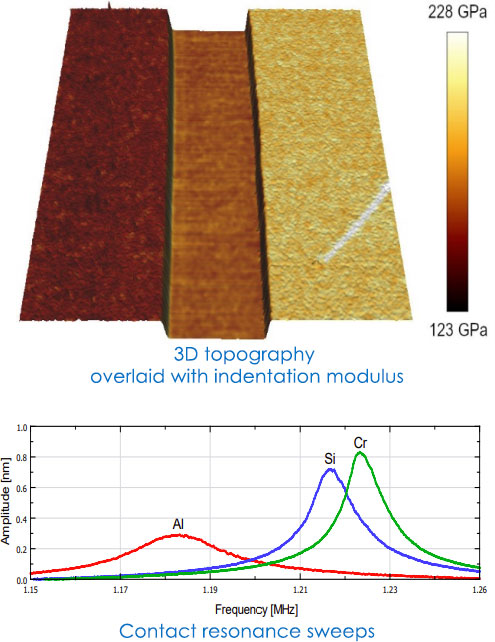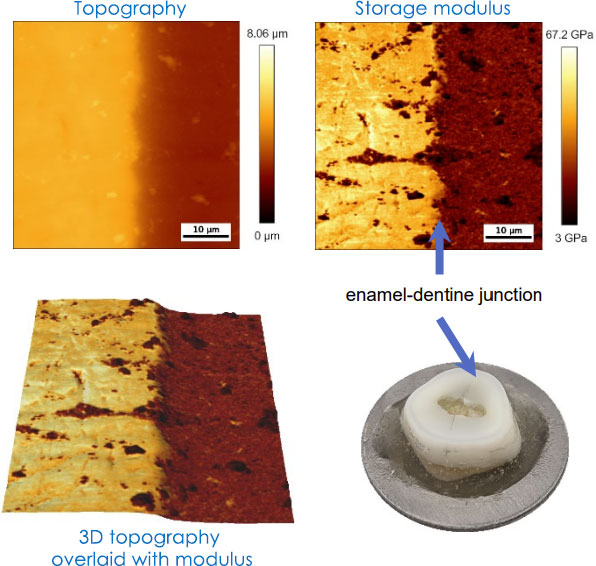New Bruker BioAFM Contact Resonance Module for Stiff Biological Samples
Bruker’s new Contact Resonance module is a powerful tool for mechanical characterisation of stiff biological samples, polymers, metals and more with AFM (Atomic Force Microscopy). Until now it was not possible to study the nanomechanical properties of samples such as teeth, bones, seeds, wood and medical implants with this level of accuracy.
Blue Scientific is the official Nordic distributor for Bruker JPK BioAFM in Norway, Sweden, Denmark, Finland and Iceland. For more information or quotes, please get in touch.
Bruker JPK BioAFM range
Contact us on +44 (0)1223 422 269 or info@blue-scientific.com
Nanomechanical Characterisation of Stiff Samples
There are already several AFM techniques for fast, high resolution quantitative nanomechanical characterisation. However, most of them are based on force spectroscopy measurement, so the finite stiffness of the cantilever means they are effectively limited to samples of approx. 10 GPa stiffness.
For stiffer samples, nanoindentation is typically employed, which damages the sample and limits the resolution. This can be a problem in solid state physics and biology, when detailed characterisation of samples such as teeth, bones and implants is required.
Contact Resonance
Contact resonance combines the speed and resolution of AFM with the ability to mechanically characterise stiff samples from approx. 0.1GPa up to 300 GPa. The cantilever is held in steady contact with the sample (contact mode), while being excited either through the tip (Ultrasonic AFM) or through the sample (Atomic Force Acoustic Microscopy).
Contact resonance is traditionally a slow, complex process, requiring specialist equipment for imaging and full-spectrum acquisition. Bruker has now removed these limitations with customised hardware, test/reference samples and easy-to-use software, all in a dedicated package.
There are two modes, including Fast Force Mapping mode which significantly reduces tip wear and sample damage, as well as providing quantitative measurements of viscoelastic properties. There’s a broad range of moduli, and you can investigate both elastic and viscoelastic properties.
Module Components
The contact resonance module contains:
- Sample holder with ultrasonic transducer for excitation of the cantilever.
- Easy-to-use software for data acquisition and analysis.
- Reference and calibration samples:
- Layered reference sample made of aluminum, silicon and chromium.
- Calibration samples of known moduli.
- Set of probes with a diamond-like carbon coating for high wear resistance.

PLL-based Imaging Mode
PLL-based imaging mode scans the sample in the classic contact mode, while a PLL is used to track the value of the contact resonance frequency.
This mode is best when the fastest results are needed, as the storage modulus of the sample can be calculated at standard imaging speeds and resolution. However the lateral forces are relatively high, so it can cause tip wear and sample damage.
Fast Force Mapping Mode
Fast force mapping mode eliminates lateral forces by halting the motion of the XY scanner during the cantilever approach and measuring the sample surface at each individual pixel. When the tip is in contact with the sample, a contact resonance tune is collected. The tip then retracts and moves on to the next pixel.
The tunes can be analysed/fitted according to the frequency and quality factor of the contact resonance. This enables the viscoelastic properties of the sample to be determined, as well as the storage modulus.
This mode has significantly reduced tip wear and sample damage; however acquisition takes slightly longer.
Applications
Contact resonance can be used to measure a wide variety of materials, including:
- Biological samples
- Polymers
- Metals
Until now it was not possible to study the nanomechanical properties of samples such as teeth, bones, seeds, wood and medical implants with this level of accuracy.
Example: Human Milk Tooth
The example below demonstrates contact resonance imaging on a cross-section of a human milk tooth. Data was acquired at the enamel-dentine junction. The modulus of the enamel and dentine was calculated as approx. 50 GPa and 18 GPa, respectively.

More Information
Full details about how contact resonance works are available in a pdf from Bruker.
BlueScientific is the official distributor of Bruker JPK BioAFM in the Nordic region. We’re available to provide quotes and answer all your questions – just get in touch:


